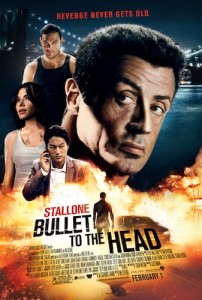Directed By: Walter Hill
Written By: Alessandro Camon (screenplay), Alexis Nolent (graphic novel “Du plomb dans la tête”)
Cast: Sylvester Stallone, Sung Kang, Sarah Shahi, Adewale Akinnuoye-Agbaje, Jason Momoa, and Christian Slater
The genre of the Hollywood action film is not a difficult one to understand. Its tropes and cliches are known the world over for the sometimes formulaic plots and sometimes forgettable characters. More often than not, the protagonists of action films adhere to the same uniform, and their plots do not largely vary between the cliches. There are of course exceptions, like the original Die Hard or the 2004 remake of Man On Fire; but those are the exceptions, not the rule. Bullet to the Head does not join that rarified circle, but it feels just a tiny bit more than just another throwaway action film.
The story is based on a French graphic novel called “Du Plomb Dans La Tête.” A hitman named Jimmy Bobo (Sylvester Stallone) is set up after a kill, and his partner is murdered by a powerful mercenary named Keegan (Jason Momoa). Bobo escapes and promises to kill the men who set him up and killed his partner. Much to his surprise and chagrin, he is approached by Taylor Kwan (Sung Kang), a Washington D.C. detective who happens to be the partner of a man that Bobo killed. Kwan quickly puts together that their respective partners were killed by the same people, and he wants Bobo to help him “bring them down.” Of course, that phrase means different things to the two men.
Bobo is reluctant, but he does agree to help. As they continue their investigation, the differences between them become very apparent. Kwan is very much by-the-book-of-the-law; Bobo is focused on what will get the job done. His kills do not require finesse, only results. What is interesting about this particular instance of Strange Bedfellows is that when the story closes, they do not grow to like each other. The gap between them remains. This is a flaw in terms of character development, but I do find some pleasure that they didn’t take the “buddy cop” route.
The film also abandons the tropes of the master plan. The masterminds, Robert Morel (Adewale Akinnuoye-Agbaje) and Marcus Baptiste (Christian Slater) literally explain their scheme to Keegan before the half-way mark. In a way, that was a savvy maneuver by the writer and director. The film’s tension does not focus on the ‘why’ of their murders, but the thrill of confrontation. In fact, while the villains are still one-sided, they have been painted with different colors than we’re used to seeing. Keegan is a blockbuster’s version of Anton Chigurh; he doesn’t kill for money. He enjoys his job of killing people, but he does have his own strange set of principles.
However, the action in the movie does not provide as much of a thrill as you would expect. The hand-to-hand combat scenes still rely too much on the close-up shots of single attacking motions in lieu of letting us appreciate the fight’s cinematography. (I digress that this is a personal pet peeve.) The blood we see in the movie’s action scenes seem far too CGI, and it even seems the wrong color.
As mentioned earlier, this film was based off a graphic novel, and it seems to have the same kind of narrative flow as a graphic novel. There are even breaks in the film’s action that could feel like the space between individual issues of a comic series. While that is a novelty, the actual storytelling of the film doesn’t seem to mesh quite the same way. The opening sequence takes place halfway through the movie, and we are brought up to speed in flashback, but it seems so unnecessary. Bobo provides narration and gives some light to his own past, but it happens infrequently, and it feels a bit too contrived.
In conclusion, in a genre that has been all but strangled by the usual tropes and cliches, I found a good degree of pleasure with Bullet to the Head. They seem aware of the most boring patterns in action movies, and they take steps to avoid using them in this film. Although that is appreciated, there is still just too much of the same-old same-old to lift it up higher. I was entertained while I watched it, but I like it less as time passes since I’ve seen it.






